Table of contents
- Legal basis for motorcycle conversions Guide to custom bikes
- What is allowed at all?
- Preliminary discussion before individual acceptance
- Headlights, indicators, taillights, lighting
- Handlebars, levers, handles, mirrors
- Bench
- Wheel, rims, wheel cover
- Exhaust and intake tract
- landing gear
- Brakes
- Off to the appointment on site
- Nothing is impossible
- Expert wanted?
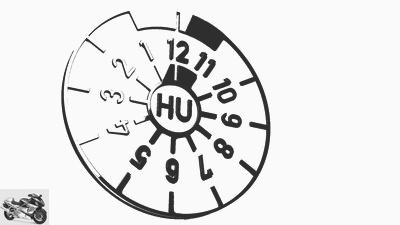
Fotalia
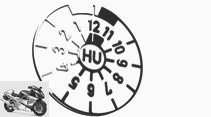

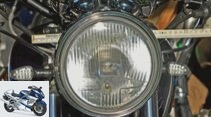
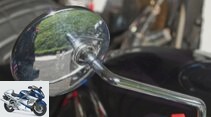
15th pictures
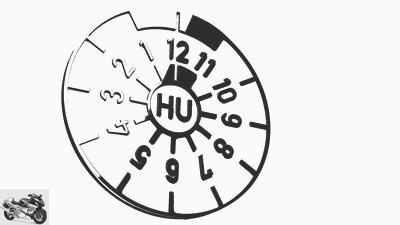
Fotalia
1/15
Legal basis for the self-made custom bike.
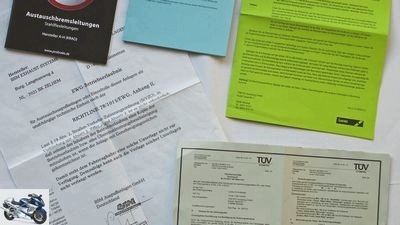
Ralf Petersen
2/15
First desk, then workbench. Nothing works without paperwork.
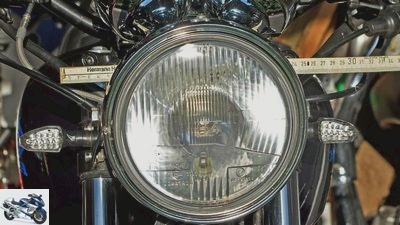
Ralf Petersen
3/15
Despite the E-mark, a mini-turn signal attachment has some pitfalls.

Ralf Petersen
4/15
E-marked mirrors guarantee: minimum size adhered to.
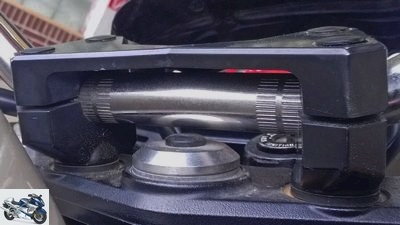
Ralf Petersen
5/15
Dilettantes at work: the handlebars do not fit the clamp.
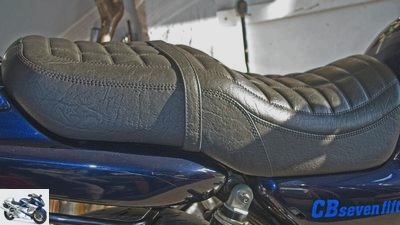
Ralf Petersen
6/15
Seat? Unproblematic. Unless you upgrade to solo.
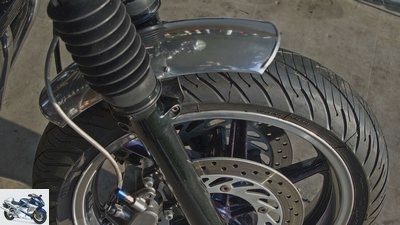
Ralf Petersen
7/15
Wheel cover: The mudguard must not be omitted.
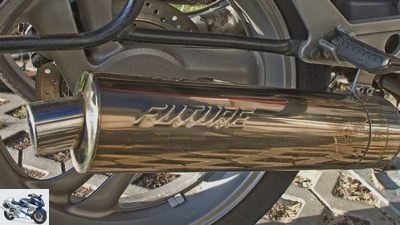
Ralf Petersen
8/15
Usually problem-free: accessory exhaust with E-mark.
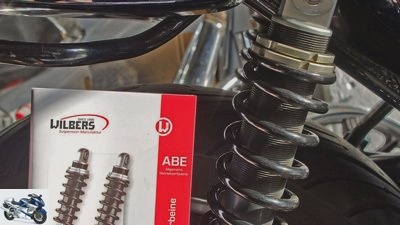
Ralf Petersen
9/15
Shock absorber? Ideal with ABE, but must be carried.

Ralf Petersen
10/15
Brake disc from the accessories? The KBA number is important.
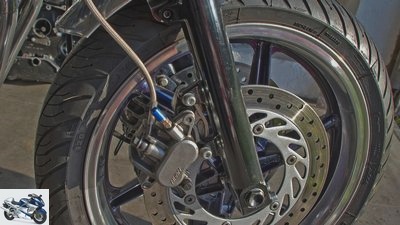
Ralf Petersen
11/15
Steel braided brake lines: lay them without chafing or kinks.
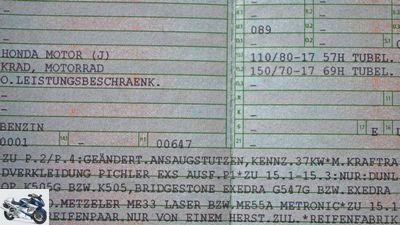
Ralf Petersen
12/15
Important changes are entered in the vehicle registration document.
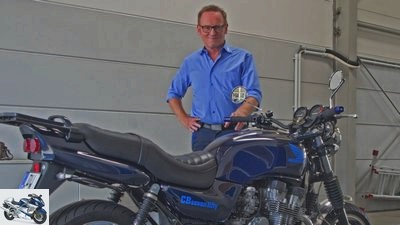
Ralf Petersen
13/15
The moment of truth: what will the expert say?
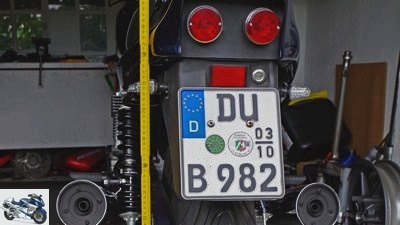
Ralf Petersen
14/15
Please touch up: taillight okay, but inadequate number plate lighting.
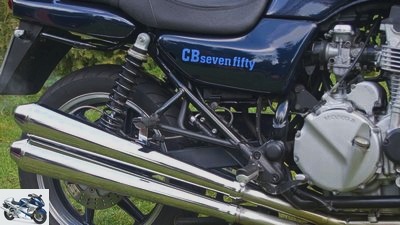
Ralf Petersen
15/15
Nothing is impossible? With a self-built four-in-four project ready for acceptance.
counselor
workshop
Legal basis for motorcycle conversions
Legal basis for motorcycle conversions
Guide to custom bikes
The dream of a custom bike that you created yourself has mercilessly failed due to many TuV hurdles. But on the other hand, there are also many auditors who can actually accompany renovation projects with heart and mind. A basic guide for do-it-yourself and do-it-yourselfers.
Ralf Petersen
02/16/2018
The current retro wave not only brings back beautiful motorcycles with a classic look, but is also accompanied by a veritable flood of new trends. Bobbers, cafe racers, scramblers … Individually styled machines in particular are very fashionable, but professional conversions are often not only really good, but often also really expensive. Since the accessories market and especially the internet trade can supply many components, the understandable desire to lend a hand to give the bike a very personal touch is growing among some bikers.
Buy complete article
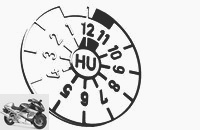
Legal basis for motorcycle conversions
Guide to custom bikes
4 pages) as PDF
€ 2.00
Buy now
Even those who can warm up to one of the many young timers, which can often be purchased at low prices, cannot avoid the requirements of the TuV for technical reasons if relevant assemblies are due to wear (e.g. brakes, struts, exhaust systems, etc. ) need to be changed. And even with slight modifications such as fancy indicators or mirrors or when exchanging handlebars, there are a few things to consider so that there are no nasty surprises at the next general inspection.
What is allowed at all?
Now the question: what is actually allowed? The Road Traffic Licensing Regulations (StVZO) prohibit the operation of a motorcycle if significant changes are made to the engine settings (performance increase / exhaust gas or noise behavior) or to safety-relevant assemblies (braking system, chassis, frame, steering, tires, etc.). Such conversion measures are only approved if the corresponding test certificates or certificates are presented and if the installation is carried out correctly.
It is easiest if the component has a general operating permit (ABE) or a KBA number (for the Federal Motor Transport Authority), because then it has already been tested. An E-mark, which certifies a corresponding test at European level, is comparable. A TuV visit is then not required. But be careful, only if all parts are correctly assembled in accordance with the associated documentation, the operating license of the motorcycle is retained, and the test certificate is only valid for mounting on a motorcycle in series production. So wild combinations are not allowed.
It gets more complicated with so-called parts certificates. In this case, a test engineer must check the correct attachment and proper function as part of a modification acceptance and confirm it with an attachment certificate. The most problematic is the assembly of accessories with so-called material reports, which naturally have no approval for special models. This is where the highest risk of rejection by the testing agency exists.
Preliminary discussion before individual acceptance
In the case of larger conversions, there is no avoiding individual acceptance: To avoid unnecessary trouble, it is advisable to contact a competent employee who specializes in the acceptance of motorcycles at the test centers (in West Germany the TuV, in East Germany the DEKRA) and in To clarify in advance what is possible and what it is better not to do. Last but not least, the cost factor is also important, because driving tests or noise measurements are of course carried out with no guarantee of success and can really cost money (acceptance with driving test approx. 350 euros, driving / stationary noise measurement approx. 230 euros). Who for his conversion parts without a certificate z. B. want to use from other motorcycles, should bring all parts, all available papers and, if necessary, reports from other motorcycles to the preliminary meeting. This is the only way to clarify whether the planned project is feasible at all. The older a motorcycle is, the lower the requirements.
Most motorcycles built after 1994 have an EC approval, older machines often still have a StVZO. Since not all regulations are created equal (e.g. wheel covers and lighting), it is important to know the difference. Here is an overview of the most important provisions:
Headlights, indicators, taillights, lighting
Replacing the old-fashioned standard turn signals for chic LED lights actually seems to be very easy, but in practice it is by no means. That only lighting equipment with certification marks may be installed and z. B. cheap LED headlights from Asia are therefore taboo, is understandable. What is astonishing, however, is the abundance of regulations for assembly in terms of number, height or distance.
Even more curious: Depending on the approval (EG or StVZO), there are sometimes differences that can hardly be understood logically, but still have to be observed. For example, the minimum distance between the indicators to the EC front / rear is 240/180 mm, but according to StVZO 340/240 mm. Attention: The distance between the front indicators and the headlights is normally 75 mm! You can mount two fog lights on a motorcycle with EC approval, according to StVZO only one. The same applies to brake lights, but you can always mount two of the tail lights. Since nobody can remember something like this, it is advisable to take a look at the regulations before installation. Do not forget that license plate lighting is mandatory and it must also illuminate the license plate sufficiently.
Handlebars, levers, handles, mirrors
In principle, they can be exchanged, but must be checked, i. H. have ABE or parts certificate. One should be particularly careful with cheap levers from the Internet. Although they often look very similar to the products of well-known manufacturers, they usually do not have an ABE, and cultivation is therefore illegal. Important when converting the handlebars: Even with the new handlebars, the steering must work perfectly and nothing must be crushed. If necessary, the steering stop must be changed. Make sure that the steering lock still works. Caution is also required when drilling into the handlebar to lay cables. If at all, holes will only be accepted on one side and between the clamps. To be on the safe side, discuss this with the examiner beforehand. With mirrors from the accessories, it makes sense to pay attention to an E-mark. Then they have the required size of 69 cm². For a machine with StVZO approval, 60 cm² is sufficient.
Bench
A conversion is usually carried out to improve comfort, to change the seat height or for visual reasons. As long as the number of seats does not change, there are no guidelines to be complied with. However, if the Cafe Racer gets a one-man seat that matches the style after the rear has been shortened, this is a conversion that requires registration and the passenger footrests must be removed.
Wheel, rims, wheel cover
A fat rear rim or a Supermoto conversion? This is also possible with a corresponding expert opinion. If, on the other hand, you use rims from other motorcycles (if possible with the same or higher power), it becomes more problematic. An (expensive) individual acceptance with driving test is before the mandatory entry.
When it comes to wheel covers, there are no longer any specific dimensions explicitly prescribed for machines with EC approval, one “sufficient” However, coverage that excludes any traffic hazard is mandatory. So it doesn’t work completely without a mudguard, and it is better to consult with the examiner before attaching the flex. On machines with StVZO approval, the lower edge of the wheel cover may end a maximum of 150 mm above the center of the rear wheel axle. However, the dimension is determined in the unloaded, i.e. rebounded state.
Enduros in particular, with their long suspension travel, often have additional plastic in the area of the wheel cover. A reflector (with a test mark!) Must generally be available at the rear, and it must not be installed higher than 900 millimeters above the floor.
Exhaust and intake tract
The basic rule is that the operating permit expires if the noise behavior deteriorates. Accessory systems for the road usually have a KBA number or an E mark, a DB killer must remain in the muffler. Any changes to the system, including during assembly, are not permitted. If the exhaust becomes louder over time, the owner is responsible. In the case of older vehicles, a self-made system may also be installed, which can be legalized by individual acceptance. From year of construction 1989, an exhaust gas test is required in addition to the noise measurement. If the corresponding values are adhered to, the entry is in principle not a problem.
landing gear
A special chapter are changes to the chassis, but above all all work on the frame. Drilling, welding and deforming are prohibited, polishing is not welcome, and material must not be removed in the process. Rear conversions are currently particularly popular with cafe racers. Shortening the frame rear in front of the shock absorber mount is often feasible after consultation with the inspector. The relevant forums (e.g. Cafe Racer Forum) offer a lot of tips and information on this. It is better to leave more complex conversions to the professionals.
If you want to change the suspension struts, fork or swing arm, you can fall back on a wide range of accessories from the accessories industry. Thanks to the appropriate expert opinion, an entry is not a problem if the assembly is correct, and it is not even necessary for struts. As with the rims, parts of other motorcycles (again, if possible, from more powerful machines) can in principle be installed on your own. Before the mandatory entry, however, there is an individual acceptance test with a driving test.
Brakes
Regardless of optical or technical changes (e.g. wave discs), changes in the brake system due to wear or aging are often unavoidable. If you do not want to use original parts, you should pay attention to expert reports and labeling when replacing panes and pads. The recommended replacement of old rubber brake lines with steel braided lines is also free of entry, provided that an ABE is available. But they have to be correct, i. H. Be installed without kinks, chafing or twisting.
Off to the appointment on site
Regardless of whether it is an individual acceptance test or a demonstration as part of a general inspection, it is always an exciting question whether conversions will be accepted or not. While preparing the article, I took my visually and technically modified Honda Sevenfifty to visit the TuV in Herne and asked the specialist to take a look at the machine. It had passed the main inspection shortly before without any problems, but not with a motorcycle specialist. I was a bit skeptical because of the short front fender and the steel braided lines that I had installed without the old (because ugly) brackets. Although there were no problems in these cases, the specialist found another, somewhat typical, error. I exchanged the standard rear light of the Sevenfifty for two small round brake lights from the accessories. The E-marking, spacing and function were in order, but the much smaller lights were now mounted so high that the number plate lighting integrated in them no longer correctly illuminates the number plate. The problem was easily solved by installing additional license plate lighting.
Nothing is impossible
You shouldn’t be put off by all the regulations, because a well-planned project that has been agreed with the inspector can also be implemented by hobby mechanics. So over the winter I almost finished a four-in-four exhaust system made of original and accessory parts for my Sevenfifty as the culmination of the conversion in the look of the 70s, which I will have the TuV approved at the beginning of the season.
Expert wanted?
An overview of TuV Nord inspectors who deal with motorcycle conversions
- Jorg Burrichter, Nordhorn jburrichter@tuev-nord.de
- Jorg Hartmann, Munster jhartmann@tuev-nord.de
- Thomas Koch, Paderborn-Soest tkoch@tuev-nord.de
- Stephan Muller, Duisburg stmueller@tuev-nord.de
- Andreas Rath, Arnsberg-HSK arath@tuev-nord.de
- Christian Schmidt, Witten cschmidt@tuev-nord.de
- Joachim Stoltmann, Melle jstoltmann@tuev-nord.de
- Peter Wagener, Erwitte pwagener@tuev-nord.de
- Werner Keil, Gelsenkirchen wkeil@tuev-nord.de
- Christoph Boermann, Herten cboermann@tuev-nord.de
Related articles
-
No new basis for motorcycle driving bans
Motorcycle noise Debate about the volume of motorcycles Ralf Schneider counselor traffic & business No new basis for motorcycle driving bans Amendment of…
-
Lazareth LM 410: Extreme street legal motorcycle
News 2022 New motorcycle items for 2022 Lazareth. 8th pictures Lazareth. 1/8 The LM 410 is a spectacular motorcycle from the French manufacturer…
-
Rear silencer accessories-exhaust homologation legal situation 2018
Lohse counselor traffic & business Rear muffler accessories-exhaust homologation legal situation 2018 Rear silencer – look at the legal situation (2018)…
-
Tips for mechanics – correct motorcycle chain maintenance
Photo: Ralf Petersen 13th pictures Ralf Petersen 1/13 / 1 / A typical lack of maintenance: everything sparkling clean, even the chain. Ralf Petersen 2/13…
-
This is how you prepare your motorcycle for the winter break
Andreas Bildl 13th pictures Petersen 1/13 Step 1: Big Wash – Thoroughly clean the motorcycle before winter. Petersen 2/13 Step 2: Jacked up – with more…
-
Legal situation for tuning measures on the motorcycle
mps photo studio counselor traffic & business Legal situation for tuning measures on the motorcycle Legal situation for tuning measures on the motorcycle…
-
Honda NC 700 S in the test: the entry-level motorcycle from Honda
Artist 12th pictures Honda 1/12 Honda NC 700 S – The naked bike is powered by an in-line two-cylinder engine of 670 cubic meters. Honda 2/12 Honda NC 700…
-
Motorcycle production, part 1: Honda
Jahn 15th pictures Jahn 1/15 How are motorcycles produced? Where do the parts come from, what happens before final assembly? These questions urged…
-
fact motorcycles Report: motorcycle design Motorcycle design Ugly or beautiful? Why do we like a motorcycle at first glance and not another one at first…
-
Manufacturer statements on the subject of motorcycle noise
Motorcycle noise Debate about the volume of motorcycles Astrid Gast – stock.adobe.com counselor traffic & business Manufacturer statements on the subject…